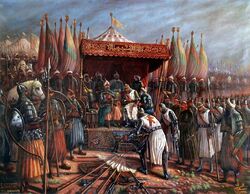Salāḥ ad-Dīn Yūsuf ibn Ayyūb (c. 1138 – 1193), better known to Europeans simply as Saladin or alternatively Anglicized as Salah Al'din,[1] was a Sultan of the Ayyubid dynasty of Egypt and Syria during the late 12th century.
He was also the commander of the Muslim armies united against the invading armies of Europe, under Richard the Lionheart during the Third Crusade, and was known for his cunning tactics, fighting skill in battle, chivalry, and tolerance.
Biography
Siege of Masyaf
In 1176, Saladin's forces laid siege to Masyaf, headquarters of the Levantine Brotherhood of Assassins, following several assassination attempts on him. Quickly taking control of Masyaf's village, the Saracen forces set up camp near the fortress.[1]
For further protection, the Saracens set up a fake tent for the Sultan in the middle of the camp to fool the Levantine Assassins. However, an Assassin spy by the name of Ahmad Sofian had infiltrated the Saracen forces, and was able to inform the Levantine Assassins of the location of the Sultan's real tent.[1]
Following this, Saladin's tent was infiltrated by the Assassin Umar Ibn-La'Ahad soon afterwards. Umar left a note attached to Saladin's belt while he was asleep, however, the Sultan woke up before he could leave, and summoned his guards. Umar managed to escape the tent, but was forced to kill a noble in the process.[1]
Saladin left the battlefield temporarily, and sent his uncle Shihab Al'din to form a truce with the Levantine Assassins, with the Saracens desiring the life of Umar in exchange for the captured Ahmad Sofian and the safety of Masyaf. True to their word, once the terms of the truce were accepted and Umar executed, the Saracens left Masyaf.[1]
Third Crusade

Saladin and Guy of Lusignan after the Battle of Hattin
At the beginning of the Third Crusade, Saladin and his men defeated Guy of Lusignan – the King of Jerusalem, who would later ally with King Richard in the siege of Acre – and Raynald of Châtillon at the Battle of Hattin, where he destroyed the entire army of the Kingdom of Jerusalem.
Following this tremendous victory, Saladin moved on to secure most of the cities and fortresses of the Kingdom of Jerusalem, until finally conquering Jerusalem itself in 1187. Following the arrival of King Richard, Saladin moved to fight against him, and their conflict emerged to follow the pattern of Richard taking ground in the Holy Land, before Saladin immediately re-took any and all ground claimed by King Richard.
Eventually, King Richard saw it fit to finally give up his ambitions towards conquering Jerusalem after losing many battles, resources, and support for his crusade, and accepted a peace treaty offered earlier by Saladin, which allowed Christians to visit Jerusalem for Pilgrimage unharmed and unmolested.
Later life and death
Saladin died on 4 March 1193, and was buried at the Umayyad Mosque, in Damascus, Syria.
Trivia
- Saladin is Anglicization of the Arabic name صلاح الدين (Salāḥ al-Dīn), meaning "Righteousness of Religion/Faith". He acquired the title after expressing his early intentions for conquering Jerusalem to his mentor, Imad ad-Din Zengi, another Muslim conqueror.
- In the 12th century, the Crusaders used the European pronunciation of "Sala-din", while the Saracens used the Arabic pronunciation of "Salāḥ ad-Dīn".
